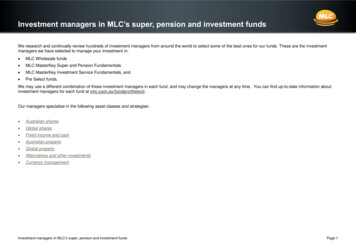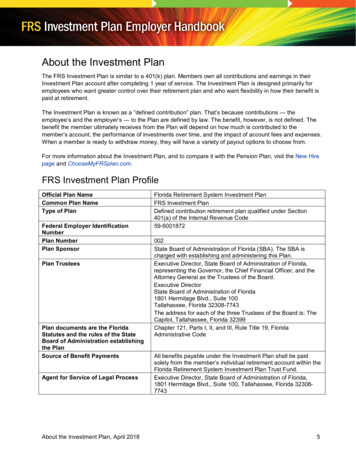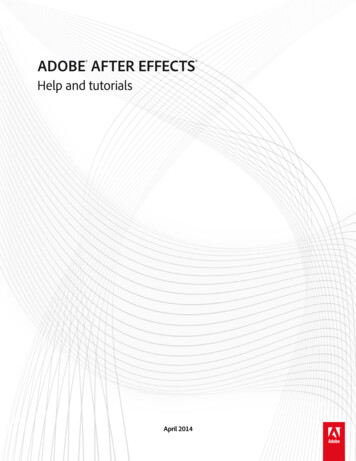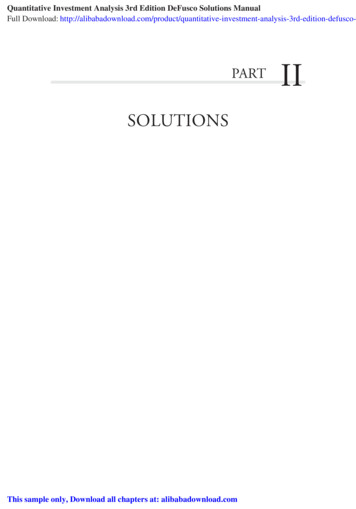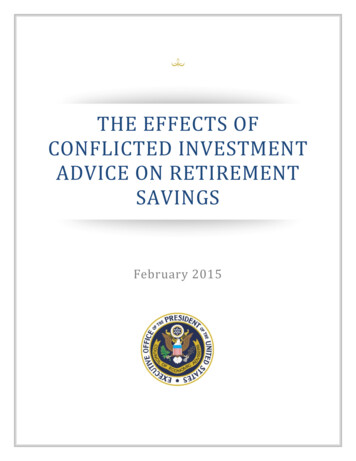
Transcription
THE EFFECTS OFCONFLICTED INVESTMENTADVICE ON RETIREMENTSAVINGSFebruary 2015
ContentsExecutive Summary . 2I.The U.S. Retirement System . 4II. The Economic Cost of Conflicted Investment Advice . 10The Evidence on Underperformance. 10The Effect of Conflicted Advice on Investment Returns . 15The Dollar Cost of Conflicted Investment Advice . 18III. Alternative Explanations for Underperformance . 22Is Underperformance the Fair Price of Advice and Other Intangible Benefits? . 22Does Underperformance Reflect the Characteristics of Households Receiving Conflicted Advice Rather thanConflict Itself? . 23IV. Conclusion . 26References. 271
Executive SummaryAmericans’ retirement income is derived from many sources, including Social Security, traditionalpensions, employer-based retirement savings plans such as 401(k)s, and Individual RetirementAccounts (IRAs). While this landscape is familiar today, it reflects a dramatic change from thelandscape 40 years ago. The share of working Americans covered by traditional pension plans—whichoffer a guaranteed income stream in retirement—has fallen sharply. Today, most workersparticipating in a retirement plan at work are covered by a defined contribution plan, such as a401(k). Importantly, the income available in retirement from a defined contribution plan depends onboth the amount initially saved and the return on those savings. The shift from traditional pensions todefined contribution plans raises important policy issues about investment responsibilities and theroles of individual households, employers, and investment advisers in ensuring the retirementsecurity of Americans.Defined contribution plans and IRAs are intricately linked, as the overwhelming majority of moneyflowing into IRAs comes from rollovers from an employer-based retirement plan, not direct IRAcontributions. Collectively, more than 40 million American families have savings of more than 7trillion in IRAs. More than 75 million families have an employer-based retirement plan, own an IRA, orboth. Rollovers to IRAs exceeded 300 billion in 2012 and are expected to increase steadily in thecoming years. The decision whether to roll over one’s assets into an IRA can be confusing and the setof financial products that can be held in an IRA is vast, including savings accounts, money marketaccounts, mutual funds, exchange-traded funds, individual stocks and bonds, and annuities. Selectingand managing IRA investments can be a challenging and time-consuming task, frequently one of themost complex financial decisions in a person’s life, and many Americans turn to professional advisersfor assistance. However, financial advisers are often compensated through fees and commissions thatdepend on their clients’ actions. Such fee structures generate acute conflicts of interest: the bestrecommendation for the saver may not be the best recommendation for the adviser’s bottom line.This report examines the evidence on the cost of conflicted investment advice and its effects onAmericans’ retirement savings, focusing on IRAs. Investment losses due to conflicted advice resultfrom the incentives conflicted payments generate for financial advisers to steer savers into productsor investment strategies that provide larger payments to the adviser but are not necessarily the bestchoice for the saver.CEA’s survey of the literature finds that: Conflicted advice leads to lower investment returns. Savers receiving conflicted advice earnreturns roughly 1 percentage point lower each year (for example, conflicted advice reduceswhat would be a 6 percent return to a 5 percent return). An estimated 1.7 trillion of IRA assets are invested in products that generally providepayments that generate conflicts of interest. Thus, we estimate the aggregate annual cost ofconflicted advice is about 17 billion each year.2
A retiree who receives conflicted advice when rolling over a 401(k) balance to an IRA atretirement will lose an estimated 12 percent of the value of his or her savings if drawn downover 30 years. If a retiree receiving conflicted advice takes withdrawals at the rate possibleabsent conflicted advice, his or her savings would run out more than 5 years earlier. The average IRA rollover for individuals 55 to 64 in 2012 was more than 100,000; losing 12percent from conflicted advice has the same effect on feasible future withdrawals as if 12,000 was lost in the transfer.The conclusions of this report are based on a careful review of the relevant academic literature but,as with any such analysis, are subject to uncertainty. However, this uncertainty should not mask theessential finding of this report: conflicted advice leads to large and economically meaningful costs forAmericans’ retirement savings. Even a far more conservative estimate of the investment losses due toconflicted advice, such as half of a percentage point, would indicate annual losses of more than 8billion. On the other hand, if conflicted advice affects a larger portion of IRA assets than the 1.7trillion considered here—or if the estimate were extended to other forms of retirement savings—thetotal annual cost would exceed 17 billion.3
I.The U.S. Retirement SystemAmericans’ retirement income comes from many sources. Social Security provides a basic foundationfor retirement security. Traditional pensions, employer-based retirement savings plans such as401(k)s, and Individual Retirement Accounts (IRAs) allow workers to set aside additional earningsexplicitly designated for retirement in a tax-advantaged way. (Table 1 provides an overview of theseforms of savings.) Other savings, whether in a bank account or a home, provide additional resourcesthat can be tapped in retirement. While this landscape is familiar today, it reflects a dramatic changefrom the landscape 40 years ago. The share of working Americans covered by traditional pensionplans—which offer a guaranteed income stream in retirement—has fallen sharply. Today the majorityof workers participating in a retirement plan at work are covered by a defined contribution plan, suchas a 401(k).Table 1. Select Forms of Tax-Preferred Retirement Savings 1Type of PlanDefined Benefit (DB)PlanDefined Contribution(DC) PlanIndividual RetirementAccount (IRA)DescriptionTraditional pensions that provide a guaranteedpayment for life. Benefits typically determinedaccording to a formula involving somecombination of age, earnings, and tenure.Retirement savings plans that allow employeeand/or employer contributions. Benefits dependon both the amount saved and the investmentreturns net of fees on those assets. Workers bearthe risk associated with asset returns. Examplesinclude 401(k)s, 403(b)s, the Federal Thrift SavingsPlan, and profit-sharing plans.Retirement savings plans independent ofemployment that allow individual contributions.Benefits depend on both the amount saved andthe investment returns net of fees on thoseassets. Individual savers bear the risk associatedwith asset returns.1This report uses the term defined contribution plan to refer to employer-based defined contribution retirement plans(i.e. excluding IRAs).4
Figure 1: Retirement Assets by Type, 1978-2013Percent100902013Government DB Plans807060Private DB Plans504030DC 82013Source: Investment Company Institute.Figure 1 shows the composition of Americans’ tax-preferred retirement savings for the period 1978 to2013. In 1978, traditional pensions accounted for nearly 70 percent of all retirement assets. Definedcontribution plans accounted for less than 20 percent and IRAs accounted for only 2 percent.Annuities accounted for the remainder. 2 By the end of 2013, traditional pensions accounted for only35 percent of retirement assets, a decrease of 32 percentage points; defined contribution plans andIRAs accounted for more than half of all retirement assets.This widely discussed shift from traditional pensions to defined contribution plans and IRAs raisesimportant policy issues. In a traditional pension, investment decisions are largely handled byprofessional managers. In an IRA, investment decisions are almost entirely left to the individual saver.Defined contribution plans, such as 401(k)s, reflect a middle ground where employers mayautomatically enroll workers in particular default products and may provide workers with access tovarious forms of advice, but may also provide a large menu of options and nearly unrestricted choiceof investment products (Vanguard 2014).This shift in investment responsibility has coincided with an explosion in the investment options andtrading platforms available. The period since 1974 has seen the advent and proliferation of indexmutual funds, discount brokerage, exchange-traded funds, online trading, and more. The number andcomplexity of the products available can make financial decisionmaking difficult (Campbell 2006,Lusardi and Mitchell 2007). Moreover, an abundance of investment options and the way in whichinvestment decisions are framed may challenge financial decisionmaking and lead to worse outcomesfor savers (Iyengar et al. 2004, Benartzi et al. 2009). All of these factors in combination have led to anincreasing role for financial advice. According to one survey, roughly half of traditional IRA-owninghouseholds have a retirement strategy created with the help of a professional financial adviser(Holden and Schrass 2015).2In Figure 1, the annuities category excludes annuities held by IRAs, 403(b) plans, 457 plans, and private pension funds.5
Table 2: Sources of Investment AdviceAdviserRegistered InvestmentAdvisers (RIAs)DescriptionReceives compensation in exchange forgiving investment advice. May alsomanage a portfolio for clients.Broker Dealers(brokers)Makes trades for a fee or commission. Abroker makes trades for a client’saccount, while a dealer makes trades forhis or her own account.Other Potential SourcesExamples include friends, family, bankers,insurance agents, accountants, andlawyers.Legal StandardFiduciary duty to client, including aduty of loyalty and a duty of care.Must serve the best interest of theclient.Recommendations must be suitablefor a client’s investment profiletaking into account factors such asage, income, net worth, andinvestment goals.Standards vary.Retirement savers may obtain investment advice from a range of sources, including two primarygroups of professionals: brokers and registered investment advisers (RIAs). Table 2 summarizes selectsources of investment advice. 3 In addition to investment and asset allocation recommendations,these advisers may provide overall savings advice, tax planning, estate planning, advice on claimingSocial Security, and other services. In this report, we use “financial adviser” broadly to include allkinds of professionals providing advice, not just RIAs.Two important ways in which advisers differ are (i) the legal and conduct standards that their advicemust meet and (ii) the ways in which they are compensated for the advice they provide. For example,advice provided by RIAs must serve the best interest of their clients and satisfy duties of loyalty andcare. Brokers’ recommendations must be suitable for the client taking into account factors such asage and income. Moreover, only registered investment advisers are permitted to give holistic advice,while brokers are restricted to providing incidental advice (Securities and Exchange Commission (SEC)2011). However, individual advisers can switch back and forth between the two regimes as theyengage in different activities, a practice known as dual hatting. As a result, consumers may not knowwhich legal or conduct regime applies to the advice they are receiving at any moment.The distinctions between the relevant legal standards are important, but they also interact with animportant second difference between advisers: differences in the ways in which they arecompensated for the advice provided. The key difference is between those advisers who receiveconflicted payments and those who do not. Conflicted payments are payments to the adviser thatdepend on the actions taken by the advisee. For example, an adviser may receive an annual paymentfor each dollar invested in certain products. Advisers who do not accept conflicted payments maycharge an hourly rate, a percentage of assets, or other similar fees that do not directly depend on theinvestment decisions made by the client. Advisers may also receive both types of compensation:conflicted payments and payments that do not directly depend on their clients’ investment decisions.Advisers accepting conflicted payments face a conflict of interest because the advice that is best fortheir own bottom line may not be the advice that is best for their customers’ savings. These3For simplicity, this report refers to both firms and the individual advisers working at those firms as brokers and RIAs.6
misaligned interests can arise from a wide range of payment arrangements. Examples includerevenue-sharing arrangements and front-end and back-end loads. 4 Table 3 summarizes select formsof conflicted payment arrangements. Advice provided by advisers who accept conflicted payments isreferred to as conflicted investment advice. While this report discusses the costs of conflictedinvestment advice, it is important to keep in mind that many financial advisers hold themselves tohigh professional standards.Table 3. Select Types of Payments Generating Conflicts of Interest 5Type of PaymentOngoing revenue-sharingarrangements, including12b-1 feesFront-end sales load,back-end sales loadSales targets, payoutsVariable commissionsDescription of Adviser’s Monetary InterestMutual funds may make ongoing annualpayments to advisers based on the advisers’clients’ investments, often specified as apercentage of assets. Known by the SEC rulethat created them, 12b-1 fees are one exampleof ongoing revenue-sharing payments.Mutual funds may charge investors a fee whenan investor buys shares (a front-end load) orsells shares (a back-end load). Most or all of thischarge is generally passed on to the advisersselling the product.Advisers may receive payouts when theyachieve certain sales targets. The payout canvary by asset class and product. In some cases,proprietary products receive higher payouts.Advisers may receive compensation throughcommissions for selling individual stocks,insurance products, and other financialproducts. The amount of the commission canvary across products and asset classes.Potential ConsequencesCreates a financial incentive todirect clients to funds with higherrevenue-sharing payments.Creates a financial incentive tosteer investors into funds withhigher loads and that pass on alarger portion of that load toadvisers. Loads also encourageexcessive trading as more tradesincrease load payments.Creates a financial incentive torecommend trading and sellingspecific products over othersbased on the schedule of payouts.Creates a financial incentive torecommend products thatgenerate higher commissions andcan encourage excessive trading.The potential for negative effects of these conflicted payments may be invisible to consumersbecause they are often unaware of the differences in payment structures and legal standards acrossadvisers and the conflicts they create. Moreover, even when consumers are aware of the differences,they can struggle to know which legal and conduct standard is relevant because advisers can switchbetween legal and conduct regimes in a given conversation with a client. In surveys, a majority ofhouseholds reports satisfaction with their advisers and at the same time express confusion and makemistakes about the different titles, legal obligations, and consumer protections that exist in theadvice industry (Consumer Financial Protection Bureau (CFPB) 2013, Government AccountabilityOffice (GAO) 2011, Investment Company Institute 1997, SEC 2011). Households also expressconfusion over the fees that they are charged, reflecting the indirect and sometimes complex pricingof financial advice, which further widens the scope for abuse (Hung et al. 2008).4See Financial Industry Regulatory Authority (FINRA) (2013), Howat and Reid (2007), Hung et al. (2008), Turner and Muir(2013), and Prentice (2011) for additional discussion of conflicts.5Conflicted payments are often split between the adviser and the adviser’s firm. The allocation between the two affectsthe size of the financial incentive the payments create, but not generally the nature of the incentive created.7
This report focuses on the impact of conflicted advice as it affects IRA owners. Unique features of theIRA market suggest that IRA investors are particularly vulnerable to conflicted advice. First, fewindividuals contribute to IRAs directly and, instead, most of the money flowing into these accountsaccumulates in employer plans and is then rolled over into an IRA when workers change jobs orretire. In 2012, Americans contributed roughly 30 billion to traditional and Roth IRAs. In the sameyear, they rolled over more than 300 billion to traditional and Roth IRAs. At the point of rollover,savers are making decisions about large quantities of money relative to the sums involved in othermore common financial decisions. Many savers may not have full knowledge about their options or acomplete understanding of the detailed regulatory differences between their employer plan and anIRA—most notably that advice to roll money out of the plan into an IRA is generally subject to muchlower standards of care than advice received in the plan. Moreover, investment fees in a typical IRAmay exceed investment fees in a typical 401(k) according to a series of recent GAO reports (GAO2009, 2011, 2013). While rolling over balances to an IRA makes financial sense for many people,when doing so incurs meaningfully higher fees, it generally does not.Second, for many Americans making decisions about their IRA investments will be one of the onlytimes they must confront the full set of investment products available in the marketplace and as suchwill be one of the most complicated savings decisions they will face in their lifetime. 6 Third, IRA assetsare largest for older households who may be more vulnerable to losses due to conflicts than othersavers (Agarwal et al. 2009, Lusardi et al. 2009). SEC and CFPB reports have found consumer financialprotection abuses that are specifically targeted at elderly households (CFPB 2013, SEC 2007).While many different financial products provide conflicted payments, the analysis in the next sectionwill largely focus on mutual fund assets. This focus is driven by the existence of high-quality empiricalevidence on the issue of conflicts of interest for this subset of the market. As shown in Figure 2,mutual funds accounted for about half of all IRA assets in 2013, or roughly 3.5 trillion.7 However, tothe degree that conflicted payments impose costs outside of mutual funds held in IRAs, the totalcosts imposed would be larger than the headline estimates in this report.6According to the Survey of Consumer Finances, nearly half of American families held retirement savings accounts,including DC plans and IRAs, in 2013. Outside of retirement accounts and pension plans, only 14 percent held individualstocks, only 8 percent held mutual funds or other pooled investment funds, and even fewer held CDs, individual bonds, orother managed assets.7Variable annuity mutual fund assets are classified with mutual funds, not annuities.8
PercentFigure 2: Allocation of IRA Assets in 201348%Stocks, Bonds,and Other AssetsMutual Funds40%5%Annuities7%Bank and Thrift DepositsSource: Investment Company Institute.9
II.The Economic Cost of Conflicted Investment AdviceThe efficiency losses arising from economic relationships involving conflicting incentives—that is,scenarios where the best financial outcome for each party in an economic relationship differs and thebehavior of one or more parties can only be imperfectly monitored—have been studied extensively inthe economics literature. These principal-agent problems have been studied across a range ofindustries and relationships, including medical care (Arrow 1963), corporate management (Jensenand Meckling 1976), performance management (Holmstrom 1982), and the mutual fund industry(Chen et al. 2013).This report focuses on quantifying the impact of conflicting incentives in the particular case offinancial advisers providing conflicted advice to IRA account holders. To do so, it turns to theempirical literature that examines conflicted payments and investment products characterized byconflicted payments. Numerous empirical studies, summarized in Table 4, identify the many coststhat result. Most of the studies in the literature summarize their results in terms ofunderperformance: the amount by which investment returns for affected products fall short of asuitably-defined comparison group.In the academic literature, practices vary in whether investment returns are presented before (gross)or after (net) expenses have been taken into account and in exactly which expenses are subtractedbefore reporting the net return. CEA’s estimated cost of conflict reflects the impact of conflictedadvice on a saver’s net return. In the discussion of the empirical evidence in this section,underperformance is often expressed in basis points. Basis points provide a convenient rescaling ofpercentage points for use when discussing numbers close to 1 percentage point: 1 basis point is equalto 0.01 percentage points, and 100 basis points is 1 percentage point.This section of the report first reviews the relevant academic literature and then applies the resultsfound in that literature to estimate the effect of conflicted advice on investment returns and theaggregate dollar cost of conflicted investment advice.The Evidence on UnderperformanceA natural place to begin estimating the costs of conflicted investment advice is with a comparison ofthe investment returns for mutual funds sold through intermediaries and characterized by conflicts ofinterest with the investment returns for funds sold directly to savers and generally not providingconflicted payments. Importantly, the distinction between these two groups of funds is not identicalto the distinction between funds purchased with advice and those without. Savers purchasing fundssold directly to the public may be receiving advice (for example, from a fee-only adviser). Researchmaking this comparison consistently finds that funds characterized by conflicted paymentssignificantly underperform funds sold directly to savers.Bergstresser et al. (2009) compare the performance of funds sold through intermediaries that tend tooffer conflicted payments with that of funds sold directly to savers, where conflicts of interest aresignificantly weaker. They find that funds sold through intermediaries deliver lower risk-adjusted10
returns. The researchers examine returns net of operating expenses, but do not include the costs ofmarketing and selling fund shares such as loads and 12b-1 fees (defined above). Since loads and 12b1 fees are primary sources of compensation for the intermediaries recommending the funds, theauthors’ finding indicates that it is not merely the cost of paying those intermediaries that leads tounderperformance. During the period covered by the study, the annual returns on domestic equityfunds sold through intermediaries were 77 basis points lower than the returns of observationallyequivalent direct-sold funds. The annual returns on bond funds sold through intermediaries were 90basis points lower than equivalent direct-sold funds. The authors estimate that thisunderperformance amounted to 4.6 billion in 2004. 8Del Guercio and Reuter (2014) corroborate the result in Bergstresser et al. (2009): direct-sold fundsoutperform funds sold through intermediaries, a difference they estimate to be 115 basis points peryear. Moreover, looking just at funds characterized by conflicted payments, the authors find thatactively-managed funds sold through intermediaries, which comprise the vast majority of all fundssold through intermediaries and feature larger conflicted payments, underperform lower-fee,passively-managed funds sold through intermediaries by 112 to 132 basis points per year; this resultdoes not extend to funds that are sold directly to savers. In other words, underperformance amongactively-managed funds is limited to the segment of the mutual fund market where the conflictedpayments are the largest. The authors conclude that this result “likely reflect[s] an agency conflictbetween brokers and their clients” as both actively-managed and passively-managed funds soldthrough intermediaries provide the same portfolio management and advisory services but providedifferent payments to the adviser.These first two studies compare investment returns for funds that tend to make conflicted paymentswith those that do not. One limitation of this type of comparison is that it may incorporatedifferences other than the presence of conflicted advice between the types of investors purchasingfunds through these two sources. For instance, investors purchasing funds through intermediariesmay be more risk-averse and less experienced with investing than those buying direct-sold sharesfrom a mutual fund sponsor. Failing to account for such differences may potentially overstate orunderstate the losses due to conflicts of interest. However, results from another strand of researchthat is not affected by this limitation find broadly similar patterns.In one study, Chalmers and Reuter (2014) compare the performance of accounts in an Oregonworkplace retirement plan when plan participants lose access to conflicted advisers. They find thatparticipants who would have otherwise used conflicted advisers when available weredisproportionately more likely to rely on the plan’s default investment options in their absence, andthat those default investment options performed better than the portfolios of those receivingconflicted advice. In the authors’ words, “brokers significantly increased annual fees, significantlydecreased annual after-fee returns, and slightly increased risk-taking relative to the counterfactualportfolio” (that is, the default investment option). The estimated magnitude of underperformance inthis study is large: 298 basis points relative to the plan’s default investment option. A portion of this8The authors find outperformance of foreign equity funds, but this result is attributable to a small number of large fundssold through a single fund family.11
large underperformance estimate is explained by a higher exposure to risky assets in broker clients’portfolios at a time when risky assets performed poorly. The authors also estimateunderperformance between portfolios selected on the basis of conflicted advice and those that arenot after controlling for various measures of investor traits, and find that these portfolios stillunderperform by approximately 125 basis points. Similarly, researchers examining retail investmentadvice in Canada and Germany, where the legal regimes differ but advisers also derive substantialcompensation from conflicted payments, find that advised accounts underperform by more than 150basis points (Foerster et al. 2014, Hackethal et al. 2012a).Conflicted payments can also lead to underperformance as a result of poor timing in investmentdecisions. Studies that compare the performance of mutual funds do not necessarily capture thiseffect, which results from the timing of individual investors’ decisions to buy and sell. While poortiming in investment decisions, referred to as market mis-timing, exists for reasons other thanconflicted payments, conflicted payments can exacerbate the problem as trading strategies with poortiming may generate higher conflicted payments. Friesen and Sapp (2007) estimate that timing issuesfrom all sources could lead to 100 to 200 basis points of annual underperformance and that theselosses appear to be larger among a particular group of funds (load funds) offering conflictedpayments. Other research also suggests that conflicted advisers often do not steer clients away fromexcessive trading, another source of investment losses due to poor timing (Hackethal et al. 2012b).12
Table 4. Evidence on the Impact of Conflicted Investment AdviceStudyBergstresser etal. (2009)Impact of ConflictLower returns,higher feesChalmers andReuter (2014)Lower returns,higher fees, biasedadviceChristoffersenet al. (2013)Biased advice,lower returns,higher feesDel Guercio andReuter (2014)Lower returns,higher feesFoerster et al.(2014)Lower returns,higher fees,inappropriate risktaking, advice isnot customizedFriesen andSapp (2007)Market mis-tim
Registered Investment Advisers (RIAs) Receives compensation in exchange for giving investment advice. May also manage a portfolio for clients. Fiduciary duty to client, including a duty of loyalty and a duty of care. Must serve the best interest of the client. Broker Dealers (brokers) Makes trades for a fee or commission. A





